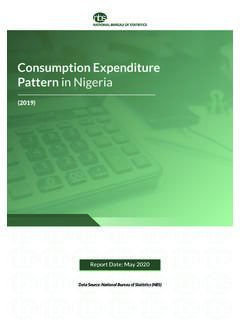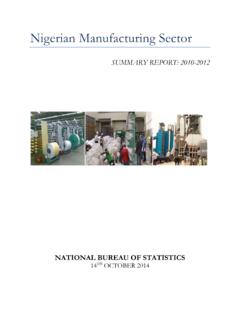Transcription of EDUCATION STATISTICS
1 EDUCATION STATISTICS . 1. Introduction EDUCATION is one of the earliest social services to be introduced to Nigeria. Initially, the majority of primary and secondary educational institutions were established and run by missionaries. A relatively few were Government-owned. In the post-Independence Nigerian Constitution, EDUCATION was on the concurrent list and was virtually left to the then Regional Governments, with the Federal Government legislating on broad policy matters. Besides the University of Ibadan (which was established in 1948) and a few non-missionary colleges in Lagos, all other non-missionary educational institutions were inherited by their regions of location with the attainment of independence in October 1960.
2 During the first military administration, the Federal Government created more States and assumed responsibility for the three Universities established by the three erstwhile regions. Subsequently, the Federal and State Governments alike established more secondary and tertiary educational institutions, and to regulate their activities, the central Government established the National Universities Commission (NUC) and the National board for Technical EDUCATION (NBTE). The National Teachers' Institute (NTI). was set up to handle primary school teachers' examinations, while admission to Universities, and more recently, Polytechnics and Colleges of EDUCATION are managed by the joint Admissions and matriculation board ( jamb ). National youth service was introduced under the National Youth Service Corps (NYSC) scheme.
3 In addition to performing their statutory functions, these bodies have tremendously facilitated the compilation of EDUCATION STATISTICS in the country. 2. Coverage, Scope, Uses and Users of EDUCATION Data EDUCATION is very important for sustaining and developing the people. With EDUCATION , people are able to endure, mature. Acquire experience, wisdom and the capability to fend for themselves as well as serve their communities and nation. EDUCATION is also both an instrument of stability and of change: stability in the sense that good traditions are documented, taught, imbibed and practised, and change because it equips people to meet new challenges. In the same vein EDUCATION is a tool for inculcating moral values in the citizen.
4 EDUCATION STATISTICS , like other social data, facilitates planning. They constitute invaluable inputs for computing important social indicators which are used to monitor trends in the quality of life and in making regional and international comparisons. 3. Sources and Methods of Compiling EDUCATION STATISTICS The following agencies are the sources of EDUCATION STATISTICS in Nigeria: Federal Ministry of EDUCATION (FME), State Ministries of EDUCATION (SMEs), National Bureau of STATISTICS (NBS), joint Admissions and matriculation board ( jamb ), National Universities Commission (NUC), National board for Technical EDUCATION (NBTE), National Commission on Colleges of EDUCATION (NCCE), National Teachers'. Institute (NTI), National Youth Service Corps (NYSC), West African Examinations Council (WAEC), National Examinations Council (NECO) and the United Nations Educational, Scientific and Cultural Organisation (UNESCO).
5 The primary sources used by these agencies are educational institutions and State and Federal Ministries of Finance. Before 1988, all STATISTICS on EDUCATION were products of the administrative system. They were records of regular educational activities, such as formal learning, teaching, provision and maintenance of facilities. In most cases, these STATISTICS were published by the agencies listed above as annual abstracts or reports, while in a few instances, they were available in worksheets of the agencies. Since EDUCATION is on the concurrent list in the Nigerian Constitution, primary and most secondary educational institutions are managed by the States. Consequently, the returns referred to in the last paragraph are either not uniformly rendered or not rendered at all to the Federal Ministry of EDUCATION which has the responsibility to collate EDUCATION STATISTICS in the country.
6 In effect, Nigeria's pre-tertiary EDUCATION data matrix in national and international publications contained many empty cells. In 1987, a UNESCO project on the computerisation of Nigeria's primary and secondary EDUCATION STATISTICS was launched. Details of its genesis and achievements are in Fagbulu (1991). In March 1988, the first national census to collect primary and secondary EDUCATION STATISTICS was conducted under the auspices of the UNESCO. Similar censuses have been the source of primary and secondary EDUCATION STATISTICS in subsequent years. Following the conduct of these censuses, the Federal Ministry of EDUCATION now collects primary and secondary EDUCATION STATISTICS directly from all the primary and secondary schools in the country.
7 The National Universities Commission collects university EDUCATION STATISTICS directly from each of the universities through returns rendered on forms designed for this purpose. Similarly, NBTE uses the polytechnics, monotechnics, vocational institutions and colleges of EDUCATION as the primary sources of STATISTICS on that sub-sector of EDUCATION . Statistical information on matriculation examinations and admissions to universities, polytechnics, monotechnics and colleges of EDUCATION are available at jamb , while WAEC and NECO are the sources of information on school certificate, general certificate of EDUCATION and other examinations which are not conducted by tertiary institutions. Statistical information on Nigerian graduates from Nigerian and foreign universities are available at the headquarters of the NYSC.
8 The National Teachers' Institute is responsible for collating information on Grade II teachers' examinations. Finally, the FME, NBS and UNESCO are sources of published EDUCATION STATISTICS on Nigeria and other countries. The data are collected by FME and NBS from most of the other agencies listed above. The items of data are either based on census/survey or administrative STATISTICS . The methods of collecting the data of each of these two types are discussed below. In the early part of the 1975-1988 Period EDUCATION STATISTICS consisted of aggregates of data submitted to FME by SME's. At that time most data from the states were affected by the desire to attract Federal EDUCATION grants allocated on school population and enrolment bases.
9 The Federal Ministry of EDUCATION conducts annual population census of primary and post-primary schools. The instruments for data collection are Primary Schools Data and Post-Primary Institution Data Forms which were returned directly to the Ministry. The following are the three major items of data on which observations are recorded, along with some of the important details of each: - general data: name/town/Local Government Area/State. - enrolment: class/gender. - number of teachers: qualification/ nationality/gender. The preliminary processing of pre-1988 EDUCATION STATISTICS consisted of editing and scrutiny, second stage analysis consisted of computerized aggregation on Local Government Area and State bases at the Computer Branch of the EDUCATION Data Bank.
10 The data as collected at that time were characterised by non- response and non-uniformity of reference periods. Consequently, Nigeria was unable to produce reliable EDUCATION STATISTICS acceptable to planners, researchers and international organisations. These are the main reasons for Government's decision to collaborate with the UNDP and the UNESCO on the computerisation of EDUCATION STATISTICS . After 1988, primary and secondary EDUCATION STATISTICS are collected through population surveys conducted nationwide on the last Wednesday of March each year. The items of data on these STATISTICS are collected by teachers trained by consultants working under the auspices of the UNESCO EDUCATION project. This is funded by the UNDP, executed by the UNESCO and implemented by the FME.




